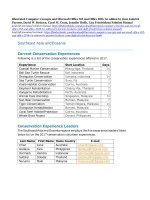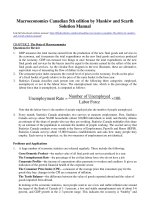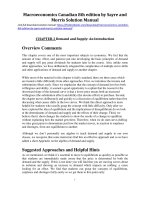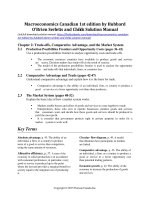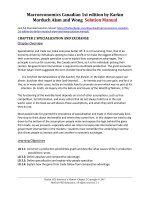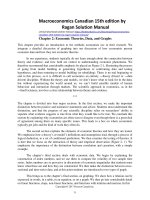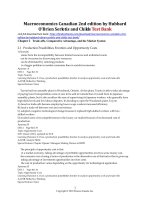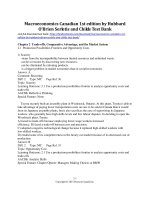Macroeconomics canadian 1st edition by hubbard OBrien serletis and childs solution manual
Bạn đang xem bản rút gọn của tài liệu. Xem và tải ngay bản đầy đủ của tài liệu tại đây (2.47 MB, 41 trang )
Macroeconomics Canadian 1st edition by Hubbard
O'Brien Serletis and Childs Solution Manual
Link full download solution manual: />
Chapter 2: Trade-offs, Comparative Advantage, and the Market System
2.1 Production Possibilities Frontiers and Opportunity Costs (pages 36–42)
Use a production possibilities frontier to analyze opportunity costs and trade-offs.
The economic resources countries have available to produce goods and services
arescarce. Decision makers face trade-offs as the result of scarcity.
The model of the production possibilities frontier is used to analyze the opportunity
costsand trade-offs that individuals, firms, or countries face.
2.2
Comparative Advantage and Trade (pages 42-47)
Understand comparative advantage and explain how it is the basis for trade.
Comparative advantage is the ability of an individual, firm, or country to produce a
goodor service at a lower opportunity cost than other producers.
2.3
The Market System (pages 48-52)
Explain the basic idea of how a market system works.
Markets enable buyers and sellers of goods and services to come together to trade.
Entrepreneurs, those who own or operate businesses, produce goods and services
thatconsumers want, and decide how these goods and services should be produced to
yield the most profit.
It is essential that government protects right to private property in order for a
marketsystem to work well.
Key Terms
Absolute advantage, p. 45. The ability of an
individual, a firm, or a country to produce
more of a good or service than competitors,
using the same amount of resources.
Allocative efficiency, p, 37. A state of the
economy in which production is in accordance
with consumer preferences; in particular, every
good or service is produced up to the point
where the last unit provides a marginal benefit to
society equal to the marginal cost of producing
it.
Circular- flow diagram, p. 49. A model
that illustrates how participants in markets
are linked.
Comparative advantage, p. 45. The ability of
an individual, a firm, or a country to produce a
good or service at a lower opportunity cost
than potential trading partners.
Economic growth, p. 42. The ability of the
economy to increase the production of goods
and services.
Copyright © 2015 Pearson Canada Inc.
CHAPTER 2 | Trade-offs, Comparative Advantage, and the Market System 21
Entrepreneur, p. 48. Someone who operates
a business, bringing together the factors of
production—labour, capital, and natural
resources—to produce goods and services.
Factor market, p. 48. A market for the factors
of production, such as labour, capital, natural
resources, and entrepreneurial ability.
Factors of production, p. 36. The inputs used
to make goods and services.
Free Market, p. 50. A market with few
government restrictions on how goods or
services can be produced or sold, on who can
buy or sell goods or services, or on how
factors of production can be employed.
Market, p. 48. A group of buyers and sellers
of a good or service and the institution or
arrangement by which they come together to
trade.
Opportunity cost, p. 37. The highest-valued
alternative that must be given up to engage in an
activity.
Product market, p. 48. Markets for
goods— such as computers—and services—
such as haircuts.
Production possibilities frontier (PPF), p.
36. A curve showing the maximum attainable
combinations of two products that may be
produced with available resources and current
technology.
Property rights, p. 51. The rights individuals or
firms have to the exclusive use of their property,
including the right to buy or sell it.
Scarcity, p. 36. A situation in which unlimited
wants exceed the limited resources available
to fulfill those wants.
Trade, p. 42. The act of buying and selling.
Chapter Outline
Managers Making Choices at Toyota
The managers at firms such as Toyota must make decisions regarding the production and marketing of
their products. These decisions include the location and relocation of manufacturing plants and the
production methods used at these plants. For example, producing more of one model of automobile means
producing fewer of other models.
Production Possibilities Frontiers and Opportunity Costs (pages 36–42)
2.1 Learning Objective: Use a production possibilities frontier to analyze opportunity costs
and
trade-offs.
Scarcity is a situation in which unlimited wants exceed the limited resources available to fulfill those
wants.
Factors of production are the inputs used to make goods and services.
A production possibilities frontier is a simple model that can be used to analyze trade-offs Toyota faces in
deciding how many of each type of automobile (in the textbook example, either Corolla sedans or Lexus
RX350 SUVs) it should produce given its limited resources and its technology.
A production possibilities frontier (PPF) is a curve showing the maximum attainable combinations of
two products that may be produced with available resources and current technology.
Copyright © 2015 Pearson Canada Inc.
22 CHAPTER 2 | Trade-offs, Comparative Advantage, and the Market System
A. Graphing the Production Possibilities Frontier
Combinations of products on the frontier are technically efficient because the maximum output is
obtained from the available resources. Combinations inside the frontier are inefficient because some
resources are not being used. Combinations outside the frontier are unattainable with current resources.
This can be used to emphasize the concept of scarcity and, since only one point on the PPF can be
chosen, it also illustrates the concept of allocative efficiency.
Opportunity cost is the highest-valued alternative that must be given up to engage in an activity.
Allocative efficiency is a state of the economy in which production is in accordance with consumer
preferences; in particular, every good or service is produced up to the point where the last unit provides a
marginal benefit to society equal to the marginal cost of producing it.
B. Increasing Marginal Opportunity Costs
A ―bowed out‖ PPF illustrates increasing marginal opportunity costs, which occur because some workers,
machines, and other resources are better suited to one use than another. Increasing marginal opportunity
costs illustrate an important concept: The more resources already devoted to any activity, the smaller the
payoff to devoting additional resources to that activity.
C. Economic Growth
Economic growth is the ability of the economy to increase the production of goods and services.
Economic growth can occur if more resources become available or if a technological advance makes
resources more productive. Growth may lead to greater increases in production for one good than another.
Growth is illustrated by an outward shift of the PPF. This shift may be symmetric or asymmetric as
illustrated in Fig 2.3 on p. 42.
Teaching Tips
By using a consumer good on the vertical axis and a capital good on the horizontal axis, it is then a simple
task to illustrate endogenous growth. Any choice other than the vertical intercept involves the production
of capital, which moves the curve out in the next period. The further down the PPF that is chosen, the
more capital is produced and the faster the economy grows. The opportunity cost of growth can be
measured in terms of foregone consumer goods. Allocation of resources to capital goods in the present
results in increased production possibilities of both goods in the future.
Advantage and Trade (pages 42-47)
2.2 Comparative
Learning Objective: Understand comparative advantage and explain how it is the basis
for trade.
Trade is the act of buying or selling. One of the great benefits of trade is that it makes it possible for
people to become better off by increasing both their production and their consumption.
A. Specialization and Gains from Trade
PPFs depict the combinations of two goods that can be produced if no trade occurs. If one individual,
firm, or country’s PPF shows greater production of both goods, then this individual, firm, or country has
an absolute advantage in producing both goods.
Copyright © 2015 Pearson Canada Inc.
CHAPTER 2 | Trade-offs, Comparative Advantage, and the Market System
23
B. Absolute Advantage versus Comparative Advantage
Absolute advantage is the ability of an individual, a firm, or a country to produce more of a good or
service than competitors, using the same amount of resources.
If the two individuals have different opportunity costs for producing two goods, each individual will have
a comparative advantage in the production of one of the goods. Comparative advantage is the ability of
an individual, a firm, or a country to produce a good or service at a lower opportunity cost than
competitors. Comparing the possible combinations of production and consumption before and after
specialization and trade occur proves that trade is mutually beneficial.
C. Comparative Advantage and the Gains from Trade
The basis for trade is comparative advantage, not absolute advantage. Individuals, firms, and countries are
better off if they specialize in producing the goods and services for which they have a comparative
advantage and obtain the other goods and services they need by trading.
Teaching Tips
Even good students have difficulty understanding comparative advantage. A good example of
comparative advantage is the career of baseball legend Babe Ruth. Before he achieved his greatest fame
as a home-run hitter and outfielder with the New York Yankees, Ruth was a star pitcher with the Boston
Red Sox. Ruth may have been the best left- handed pitcher in the American League during his years with
Boston (1914–1919), but he was used more as an outfielder in his last two years with the team. In fact, he
established a record for home runs in a season (29) in 1919. The Yankees acquired Ruth in 1920 and
made him a full-time outfielder. The opportunity cost of this decision for the Yankees was the wins he
could have earned as a pitcher. But because New York already had skilled pitchers, the opportunity cost
of replacing him as a pitcher was lower than the cost of replacing Ruth as a hitter. No one else on the
Yankees could have hit 54 home runs, Ruth’s total in 1920; the next highest total was 11. It can be argued
that Ruth had an absolute advantage as both a hitter and pitcher in 1920, but a comparative advantage
only as a hitter.
The Market System (pages 48-53)
2.3 Learning Objective: Explain the basic idea of how a market system
works.
A market is a group of buyers and sellers of a good or service and the institution or arrangement by
which they come together to trade. A product market is a market for goods—such as computers—or
services—such as haircuts. A factor market is a market for the factors of production, such as labour,
capital, natural resources, and entrepreneurial ability.
An Entrepreneur is someone who operates a business, bringing together the factors of
production— labour, capital, and natural resources—to produce goods and services.
Factors of production are the inputs used to make goods and services.
A. The Circular Flow of Income
A circular-flow diagram is a model that illustrates how participants in markets are linked. The diagram
demonstrates the interaction between firms and households in both product and factor markets.
Copyright © 2015 Pearson Canada Inc.
24 CHAPTER 2 | Trade-offs, Comparative Advantage, and the Market System
B. The Gains from Free Markets
A free market is a market with few government restrictions on how goods or services can be produced or
sold, on who can buy or sell goods or services, or on how factors of production can be employed. Adam
Smith is considered the father of modern economics. His book, An Inquiry into the Nature and Causes of
the Wealth of Nations, published in 1776, was an influential argument for the free market system. A key
to understanding Adam Smith’s argument is the assumption that individuals usually act in a rational, selfinterested way. This assumption underlies nearly all economic analysis.
C. The Legal Basis of a Successful Market System
The absence of government intervention is not enough for a market economy to work well. Government
must provide secure rights to private property. Government can aid the working of a market by enforcing
contracts between individuals through an independent court system. Property rights refer to the rights
that individuals or firms have to the exclusive use of their property, including the right to buy or sell it.
Property rights in Canada are based on British common law (except in Quebec, where the civil code
system is in effect). The Sale of Goods Act governs contract law for the sale of goods except land.
Teaching Tips
To initiate class discussion regarding intellectual property rights, ask students these questions:
1. How many of you have downloaded music via the Internet?
2. Should the government have the right to grant exclusive rights to musicians and other artists to
produce and sell their creative works?
3. Should the government fine or prosecute individuals who illegally obtain music, books, movies, and
other creative works in violation of property rights laws?
Note to instructor: Canada’s Copyright Act permits copying onto blank cassettes and blank CDs, and a
levy is charged on the purchase of this type of recordable medium. However, digital recording devices
such as MP3 players are not included.
Extra Solved Problem 2.3
Adam Smith’s “Invisible Hand”
Alan Krueger, an economist at Princeton University who served as chair of the Council of Economic
Advisers in the Obama administration, has argued that Adam Smith ―worried that if merchants and
manufacturers pursued their self-interest by seeking government regulation and privilege, the invisible
hand would not work its magic.‖
Source: Alan B. Krueger, ―Rediscovering the Wealth of Nations,‖ New York Times, August 16, 2001.
a.
What types of regulation and privilege might merchants and manufacturers seek from the
government?
b.
How might these regulations and privileges keep the invisible hand from working?
Solving the Problem
Step 1:
Review the chapter material.
This problem is about how goods and services are produced and sold and how factors of
production are employed in a free market economic system as described by Adam Smith in
Copyright © 2015 Pearson Canada Inc.
CHAPTER 2 | Trade-offs, Comparative Advantage, and the Market System 25
Step 2:
Step 3:
An Inquiry into the Nature and Causes of the Wealth of Nations. You may want to review the
section ―The Gains from Free Markets,‖ which begins on page 50.
Answer part (a) by describing the economic system in place in Europe in 1776.
At the time, governments gave guilds—associations of producers—the authority to control
production. The production controls limited the amount of output of goods such as shoes and
clothing, as well as the number of producers of these items. Limiting production and
competition led to higher prices and fewer choices for consumers. Instead of catering to the
wants of consumers, producers sought favours from government officials.
Answer part (b) by contrasting the behaviour of merchants and manufacturers
under a guild system and a market system.
Because governments gave producers the power to control production, producers did not have
to respond to consumers’ demands for better quality, greater variety, and lower prices. Under
a market system, producers who sell poor- quality goods at high prices suffer economic
losses; producers who provide better -quality goods at low prices are rewarded with profits.
Therefore, it is in the self -interest of producers to address consumer wants. This is how the
invisible hand works in a free market economy, but not in most of Europe in the eighteenth
century.
Extra Economics in Your Life:
International Trade and Household Income
Outsourcing refers to firms producing goods and services outside of their home country. Economists and
policymakers have debated the effect of international trade and outsourcing on employment in most
industrialized countries. Mark Carney, former Governor of the Bank of Canada and current Governor of
the Bank of England, in a September 2012 speech said ―Canada’s improved terms of trade cause income,
wealth, and GDP to rise.‖
Questions: (a) Should Canada eliminate all trade barriers if this increases the risk of some workers losing
their jobs to outsourcing? (b) What type of job would make you more or less vulnerable to outsourcing?
Answers: (a) Given the opposition from firms and workers in industries that would be harmed by free trade,
it is unlikely that Canada would eliminate all internal and external trade barriers. Studies shows that opposition
to free trade has a significant cost. (b) The jobs most vulnerable to outsourcing are primarily the relatively
lower-wage positions.
Source: Mark Carney, ―Dutch Disease‖, Bank of Canada Sept 7, 2012.
/>
SOLUTIONS TO END-OF-CHAPTER EXERCISES
Answers to Thinking Critically Questions
1. As we saw in the chapter, most production possibilities frontiers are not straight lines, but bow
outwards. Toyota has a number of facilities dedicated to the production of diesel engines, which could not
easily be used to produce hybrid cars. As a result the cost of switching to producing nothing but hybrids
would be very expensive for Toyota in terms of lost production.
2. Toyota cannot fill these orders using only its Canadian plant. The combination lies outside the
production possibility frontier and is therefore unattainable.
Copyright © 2015 Pearson Canada Inc.
26 CHAPTER 2 | Trade-offs, Comparative Advantage, and the Market System
Review Questions
Production Possibilities Frontiers and Opportunity Costs (pages 36-42)
2.1 Learning Objective: Use a production possibilities frontier to analyze opportunity costs
and trade-offs.
1.1 The production possibilities frontier (PPF) is a curve showing all the attainable combinations of two
products that may be produced with available resources and existing technology. Combinations of goods
that are on the frontier are efficient because all available resources are being fully utilized, and the fewest
possible resources are being used to produce a given amount of output. Points inside the production
possibilities frontier are inefficient, because the maximum output is not being obtained from the available
resources. A production possibilities frontier will shift outward (to the right) if more resources become
available for making the products or if technology improves so that firms can produce more output with
the same amount of inputs.
1.2 Increasing marginal opportunity costs means that as more and more of a product is made, the
opportunity cost of making each additional unit rises. It occurs because the first units of a good are made
with the resources that are best suited for making it, but as more and more of the product is made,
resources must be used that are better suited for producing something else. Increasing marginal
opportunity costs implies that the production possibilities frontier is bowed out—that its slope gets
steeper and steeper as you move down the production possibilities frontier.
Advantage and Trade (pages 42-47)
2.2 Comparative
Learning Objective: Understand comparative advantage and explain how it is the basis
for trade.
2.1 Absolute advantage is the ability to produce more of a good or service than competitors using the
same amount of resources. Comparative advantage is the ability to produce a good or service at a lower
opportunity cost than competitors. It is possible to have a comparative advantage in producing a good
even if someone else has an absolute advantage in producing that good (and every other good). Unless the
two producers have exactly the same opportunity costs of producing two goods—the same trade -off
between the two goods—one producer will have a comparative advantage in making one of the goods and
the other producer will have a comparative advantage in making the other good.
2.2 The basis for trade is comparative advantage. If each party specializes in making the product for
which it has the comparative advantage, they can arrange a trade that makes both of them better off. Each
party will be able to obtain the product made by its trading partner at a lower opportunity cost than
without trade.
The Market System (pages 48-52)
2.3 Learning Objective: Explain the basic idea of how a market system
works.
3.1 A circular-flow diagram illustrates how participants in markets are linked. It shows that in factor
markets, households supply labour and other factors of production in exchange for wages and other
payments from firms. In product markets, households use the payments they earn in factor markets to
purchase the goods and services produced by firms.
Copyright © 2015 Pearson Canada Inc.
CHAPTER 2 | Trade-offs, Comparative Advantage, and the Market System 27
3.2 A free market is one with few government restrictions on how goods or services can be produced or
sold, or on how factors of production can be employed. Economic decisions are made by buyers and
sellers in the marketplace. In a centrally planned economy, the government—rather than households and
firms—makes almost all the economic decisions. Free market economies have a much better track record
of providing people with rising standards of living.
3.3 Private property rights are the rights that individuals or firms have to the exclusive use of their property,
including the right to buy or sell it. If individuals and firms believe that property rights are not well enforced,
they will be reluctant to risk their wealth by opening new businesses. Therefore, the enforcement of property
rights and contracts is vital for the functioning of the economy. Independent courts are crucial because
property rights and contracts will be enforced only if judges make impartial decisions based on the law, rather
than decisions that favour powerful or politically connected individuals.
Problems and Applications
Production Possibilities Frontiers and Opportunity Costs (pages 36-42)
2.1 Learning Objective: Use a production possibilities frontier to analyze opportunity costs
and trade-offs.
1.1
a. The production possibilities frontiers in the figure are bowed to the right from the origin
because of increasing marginal opportunity costs. The drought causes the production
possibilities frontier to shift to the left. See graph below in part (b).
b. The genetic modifications would shift the maximum soybean production to the right (doubling
it), but not the maximum cotton production.
1.2 Increased safety will decrease gas mileage, as shown in the figure below. Trade-offs can be between
physical goods, such as cotton and soybeans in problem 1.1, or between less tangible features such as
mileage and safety.
Copyright © 2015 Pearson Canada Inc.
28 CHAPTER 2 | Trade-offs, Comparative Advantage, and the Market System
1.3
You would still have an opportunity cost represented by the next best use of your time.
1.4
a.
If you spend all five hours studying for your economics exam, you will score a 95 on the
exam; therefore, your production possibilities frontier will intersect the vertical axis at 95. If
you devote all five hours to studying for your chemistry exam, you will score a 91 on the
exam; therefore, your production possibilities frontier will intersect the horizontal axis at 91.
b. The points for choices C and D can be plotted using information from the table. Moving from
choice C to choice D increases your chemistry score by four points, but lowers your economics
score by four points. Therefore, the opportunity cost of increasing your chemistry score by four
points is the four point decline in your economics score.
c. Choice A might be sensible if the marginal benefits of doing well on the chemistry exam are
low relative to the marginal benefits from doing well on the economics exam—for example, if
the chemistry exam is only a small portion of your grade but the economics exam is a large
portion of your grade; or if you are majoring in economics and don’t care much about
Copyright © 2015 Pearson Canada Inc.
CHAPTER 2 | Trade-offs, Comparative Advantage, and the Market System 29
chemistry; or if you already have an A sewn up in chemistry but the economics professor will
replace a low exam grade with this exam grade.
1.5 Your report should focus on the opportunity costs of spending more money on research to find a cure
for heart disease. While heart disease kills thousands of Canadians every year, you need to consider what
else could be done with the government resources your minister is considering spending. These same
resources could be spent on preventative programs, the arts, roads, etc. You also need to consider the
impact the additional spending is likely to have on heart disease treatments. These factors make many
government decisions very difficult to make.
1.6. The government should consider whether the costs involved in either of the two programs exceed the
benefits received from the programs. If the government decides that the costs of program A exceed its
benefit, it may decide that the funds would be better spent on program B. Program A will allow four more
students to participate than program B, but at an extra cost of $ 812.5 per participant. Although this would
be a difficult trade -off to consider, spending less even though four fewer students can participate would
save resources that could be used for other purposes.
Comparative Advantage and Trade (pages 42-47)
2.2 Learning Objective: Understand comparative advantage and explain how it is the basis
for trade.
2.1 In the example in Figure 2.4 the opportunity cost of one pound of apples is one pound of cherries to
you, and two pounds of cherries to your neighbour. Any price of apples between one and two pounds of
cherries will be a fair trading price, and because ten pounds of apples for fifteen pounds of cherries is the
same as one pound of apples for 1.5 pounds of cherries, it falls within this range. We could take any other
value in this range to complete the table. Let’s take, for example, 1.25 pounds of cherries per pound of
apples. We will keep the pounds of apples traded as before at ten. The completed table will now be as
follows:
TABLE 2.1: A Summary of the Gains from Trade
You
Apples
(pounds)
Production and consumption
without trade
Production with trade
Consumption with trade
Gains from trade (increased
consumption)
Your Neighbour
Cherries
(pounds)
12
Apples
(pounds)
9
0
Cherries
(pounds)
8
20
42
0
10
10 × 1.25 = 12.5
10
60 − 12.5 = 47.5
2
12.5 − 12 = 0.5
1
47.5 − 42 = 5.5
60
Note that both you and your neighbour are better off after trade than before trade. Note also that this rate
of trading cherries for apples is better for your neighbour than the original rate of trading and worse for
you.
2.2 Yes, the United States would have benefited from importing those products for which Britain had a
comparative advantage, which, in fact, is what happened.
Copyright © 2015 Pearson Canada Inc.
30 CHAPTER 2 | Trade-offs, Comparative Advantage, and the Market System
2.3
a. When France produces one more bottle of wine, it produces two fewer pounds of schnitzel.
When Germany produces one more bottle of wine, it produces three fewer pounds of schnitzel.
Therefore, France’s opportunity cost of producing wine—two pounds of schnitzel—is lower than
Germany’s—three pounds of schnitzel. When Germany produces one more pound of schnitzel, it
produces 0.33 fewer bottles of wine. When France produces one more pound of schnitzel, it
produces 0.50 fewer bottles of wine. Therefore, Germany’s opportunity cost of producing
schnitzel—0.33 bottles of wine—is lower than that of France—0.50 bottles of wine. We can
conclude that France has the comparative advantage in making wine and that Germany has the
comparative advantage in making schnitzel.
b. We know that France should specialize where it has a comparative advantage and Germany
should specialize where it has a comparative advantage. If both countries specialize, France
will make four bottles of wine and zero pounds of schnitzel, and Germany will make zero
bottles of wine and fifteen pounds of schnitzel. After both countries specialize, France could
then trade three bottles of wine to Germany in exchange for seven pounds of schnitzel. This
will give France the same amount of wine as they initially had, but an extra one pound of
schnitzel. Germany will have three bottles of wine and eight pounds of schnitzel—that is, the
same amount of wine, but more schnitzel. Other mutually beneficial trades are possible as
well.
2.4 An individual or a country cannot produce beyond its production possibilities frontier. The production
possibilities frontier shows the most that an individual or country can produce for a given amount of
resources and technology. Without trade an individual or country cannot consume beyond its production
possibilities frontier, but with specialization and trade an individual or country can consume beyond its
production possibilities frontier. In Figure 2.5, both you and your neighbour were able to consume
beyond your production possibilities frontiers, and in Solved Problem 2.2, both Canada and the United
States were able to consume beyond their production possibilities frontiers.
2.5 Specialization and trade are about standard of living, not jobs. In both cases, individuals and countries
have jobs. You have a job if you produce everything yourself and do not trade with others, and you have a
job if you specialize and trade with others. But your standard of living will be higher if you specialize and
trade. A country will have jobs if does not trade with other countries, and it will have jobs if it specializes
and trades with other countries, but its standard of living will be higher if it specializes and trades with
other countries.
2.6 Importing only products that could not be produced here would result in Canada producing— rather
than importing—many goods for which it does not have a comparative advantage. These products would
be produced at a higher opportunity cost than if they had been imported.
The Market System (pages 48-52)
2.3 Learning Objective: Explain the basic idea of how a market system
works.
3.1
a. An auto purchase takes place in the product market. The household (George) demands the good
and the firm (Toyota) supplies the good.
b. The labour market is a factor market. Households supply labour and the firm demands labour.
Copyright © 2015 Pearson Canada Inc.
CHAPTER 2 | Trade-offs, Comparative Advantage, and the Market System 31
c. The labour market is a factor market. The household (George) supplies the factor of production
(labour), while the firm (McDonald’s) demands it.
d. The land market is a factor market. The household supplies the factor of production (land) and
the firm (McDonald’s) demands it.
3.2 Adam Smith was making the ―invisible hand‖ argument that, in pursuing their self-interest, business
people end up producing the goods and services most desired by consumers.
3.3 Adam Smith realized—as economists today realize—that people’s motives can be complex. But in
analyzing people in the act of buying and selling, economists have concluded that in most instances, the
motivation of financial reward provides the best explanation for the actions people take. Moreover, being
self-interested—looking out for your own well-being and happiness—and being selfish—caring only
about yourself—are not exactly the same things. Many successful business people are, in fact, generous:
donating to charity, volunteering for activities, and otherwise acting in a generous way. This is not
inconsistent with making business decisions that maximize profits for their companies.
3.4
a. ―Psychic rewards‖ refer to the psychological benefits of, in this case, buying lottery tickets,
which provide the excitement of playing the lottery and the chance of winning big.
b. An entrepreneur might receive the psychic rewards of creating and running his or her own
business along with the chance of making large profits.
c. Answers will vary here. Elements of being an entrepreneur do appear to be similar to buying a
lottery ticket, with the psychic rewards of playing the game along with the possibly of large
returns. Other elements may differ, such as the probability of success.
3.5 Having secure property rights would enable resource owners to use their resources in more efficient
ways, because they would spend less time on activities such as guarding their property. Owners would
also be able to make improvements to their property without fear that someone would seize the property.
They would also better able to finance a business by borrowing money, using their property as collateral
for a loan.
Copyright © 2015 Pearson Canada Inc.
Trade-offs, Comparative
Advantage, and the Market System
Copyright © 2015 Pearson Canada Inc.
1 of 28
Learning Objectives
2.1
Production Possibilities Frontiers and Opportunity Costs
2.2
Comparative Advantage and Trade
2.3
The Market System
Copyright © 2015 Pearson Canada Inc.
2 of 28
Managers Make Choices at Toyota
To compete in the automobile market, the managers of Toyota must
make many strategic decisions, such as:
• Whether to introduce new car models.
• Where in the world to advertise.
• Whether to concentrate production in Japanese facilities or to build
new factories in overseas markets.
• Which quantities of which models to produce.
• AN INSIDE LOOK on page 54 discusses how managers decide
between producing hybrid cars and diesel cars, and improving existing
gasoline-powered models.
Copyright © 2015 Pearson Canada Inc.
3 of 28
Economics in Your Life
The Trade-offs When You Buy a Car
When you buy a car, you probably consider factors such as safety and fuel
efficiency. To increase fuel efficiency, automobile manufacturers make cars
small and light, but because large cars absorb more of the impact of an
accident than do small cars, people are usually safer driving large cars.
See if you can answer these questions by the end of the chapter:
What can we conclude from these facts about the relationship between
safety and fuel efficiency?
Under what circumstances would it be possible for automobile manufacturers
to make cars safer and more fuel efficient?
Scarcity A situation in which unlimited wants exceed the limited resources
available to fulfill those wants.
Scarcity requires trade-offs. Goods and services and the economic
resources used to make them, or factors of production—workers, capital,
natural resources, and entrepreneurial ability—are scarce.
Copyright © 2015 Pearson Canada Inc.
4 of 28
Production Possibilities Frontiers and Opportunity Costs
2.1 LEARNING OBJECTIVE
Use a production possibilities frontier to analyze opportunity costs and trade-offs.
Production possibilities frontier (PPF) A curve showing the maximum
attainable combinations of two products that may be produced with
available resources and current technology.
Copyright © 2015 Pearson Canada Inc.
5 of 28
Graphing the Production Possibilities Frontier
Figure 2.1
Toyota’s Production Possibilities Frontier
Toyota faces a trade-off: To build one more
sedan, it must build one less SUV. The
production possibilities frontier illustrates
the trade-off Toyota faces. Combinations
on the production possibilities frontier—
such as points A, B, C, D, and E —are
technically efficient because the maximum
output is being obtained from the available
resources. Combinations inside the
frontier—such as point F —are inefficient
because some resources are not being
used. Combinations outside the frontier—
such as point G —are unattainable with
current resources.
Opportunity cost The highest-valued alternative that must be given up to
engage in an activity.
Copyright © 2015 Pearson Canada Inc.
6 of 28
Making
the
Facing Trade-offs in Health Care Spending
Connection
Spending more on health care means
spending less on other goods and services .
Spending more on health care would mean
that less funding is available for all the other
government programs, such as education,
housing, infrastructure, and so on. If
governments increase taxes to fund higher
health care costs (instead of cutting spending
in other areas), people will have less money
for the purchases they want to make. Very
soon governments will have to make real and
meaningful choices about the areas that
will receive funding. If doctors and nurses are
paid more or more doctors and nurses
are hired, who are we going to pay less or
what services will receive less funding? Will
there be fewer teachers? Fewer police
officers? More roads in disrepair? Will we
have less money to spend on ourselves?
Scarcity of resources means that these
sorts of tradeoffs have to be made.
Your Turn:Test your understanding by doing related problems 1.5 and 1.6 on page 57 at the end of this chapter
Copyright © 2015 Pearson Canada Inc.
7 of 28
Figure 2.2 Increasing Marginal Opportunity Costs
As the economy moves down the
production possibilities frontier, it
experiences increasing marginal
opportunity costs because
increasing automobile production
by a given quantity requires larger
and larger decreases in tank
production. For example, to
increase automobile production
from 0 to 200—moving from point
A to point B—the economy has to
give up only 50 tanks. But to
increase automobile production
by another 200 vehicles—moving
from point B to point C—the
economy has to give up 150
tanks.
The more resources already devoted to an activity, the smaller the payoff
to devoting additional resources to that activity.
Copyright © 2015 Pearson Canada Inc.
8 of 28
Economic growth The ability of the economy to increase the production of
goods and services.
Figure 2.3 Economic Growth
Panel (a) shows that as more economic resources become available and technological
change occurs, the economy can move from point A to point B, producing more operations
and producing more cars. Panel (b) shows the results of technological change in the
automobile industry that increases the quantity of cars workers can produce per year while
leaving unchanged the maximum quantity of operations that can be produced. Shifts in the
production possibilities frontier represent economic growth.
Copyright © 2015 Pearson Canada Inc.
9 of 28
Comparative Advantage and Trade
2.2 LEARNING OBJECTIVE
Understand comparative advantage and explain how it is the basis for trade.
Copyright © 2015 Pearson Canada Inc.
10 of 28
Specialization and Gains from Trade
Figure 2.4 Production Possibilities for You and Your Neighbor, without Trade
The table shows how many kilograms of apples and how many kilograms of cherries you
and your neighbour can each pick in one week.
Panel (a) shows your PPF. If you devote all your time to picking apples and none of your
time to picking cherries, you can pick 20 pounds. If you devote all your time to picking
cherries, you can pick 20 kilograms.
Panel (b) shows that if your neighbour devotes all her time to picking apples, she can pick
30 kg. If she devotes all her time to picking cherries, she can pick 60 kg.
Copyright © 2015 Pearson Canada Inc.
11 of 28
Trade The act of buying and selling.
Figure 2.5 Gains from Trade
When you don’t trade with your neighbour, you pick and consume 8 kg of apples and 12
kg of cherries per week—point A in panel (a). When your neighbour doesn’t trade with
you, she picks and consumes 9 kg of apples and 42 kg of cherries per week—point C in
panel (b). If you specialize in picking apples, you can pick 20 kg. If your neighbour
specializes in picking cherries, she can pick 60 kg. If you trade 10 kg of your apples for 15
kg of your neighbour’s cherries, you will be able to consume 10 kg of apples and 15 kg of
cherries— point B in panel (a). Your neighbour can now consume 10 kg of apples and 45
kg of cherries—point D in panel (b). You and your neighbour are both better off as a result
of trade.
Copyright © 2015 Pearson Canada Inc.
12 of 28


